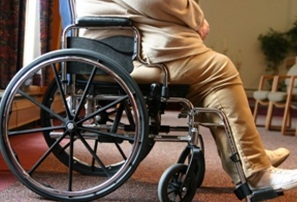People with disabilities struggle more with obesity
Obesity and its related health problems impacts far more people with a disability than previously reported, according to new research in the American Journal of Preventive Medicine.
About 54 million people in the United States have a disability that affects mobility. The study looked at how these disabilities affect the prevalence of obesity and chronic conditions such as diabetes and high blood pressure.
Lead author Katherine Froehlich-Grobe , associate professor at University of Texas School of Public Health in Dallas, said the main impetus of the study was to assess the rate of obesity among people with disabilities based on actual measurements rather than people’s self-reported height and weight, which are often inaccurate.
The researchers used six sets of data from the National Health and Nutritional Examination Survey (1999–2010) to compare the rates of obesity and extreme obesity among 11,556 adults with disabilities and 20,434 adults without disabilities. The most common disabilities affecting mobility were arthritis and back and neck problems. Chronic disease risk factors, including blood pressure, lipids and glucose levels were also compared by weight and severity and status of disability.
The study found that 41.6 percent of people with disabilities were obese and 9.3 percent were extremely obese. In contrast, 29.2 percent of those without a disability were obese and 3.9 percent extremely obese.
People with disabilities at all weight categories were significantly more likely to report having high blood pressure, high cholesterol, or diabetes and to have been prescribed medications for these conditions.
Healthcare providers should be encouraged to include individuals with disabilities in their clinical weight management efforts, suggest the researchers.
“Physical activity and exercise are critical to weight management and those with disabilities should also be as active as they can within the limits of their function and health,” said Froehlich-Grobe. “Common forms of exercise and activity [include] walking or bicycling, so the problem faced by providers is knowing what to recommend to those who face mobility issues and for whom walking is neither feasible or advisable.”
Dr. Lawrence J. Cheskin , director of Johns Hopkins Weight Loss Management Center in Baltimore, said patients with disabilities treated at his center are indeed faced with more challenges, since physical activity may be less possible as a means of preventing or treating weight gain.
“Food may also be a source of pleasure and comfort even more than in the general population,” Cheskin said. “We tend to focus on addressing intake, as this is the area most likely to result in improvements in weight.”
แสดงความคิดเห็น
รายละเอียดกระทู้
People with disabilities struggle more with obesity http://www.stltoday.com/lifestyles/health-med-fit/health/health-matters/people-with-disabilities-struggle-more-with-obesity/article_6e69d37a-bfc5-5de3-bd80-e3c0aa05ff6c.html Obesity and its related health problems impacts far more people with a disability than previously reported, according to new research in the American Journal of Preventive Medicine. About 54 million people in the United States have a disability that affects mobility. The study looked at how these disabilities affect the prevalence of obesity and chronic conditions such as diabetes and high blood pressure. Lead author Katherine Froehlich-Grobe, associate professor at University of Texas School of Public Health in Dallas, said the main impetus of the study was to assess the rate of obesity among people with disabilities based on actual measurements rather than people’s self-reported height and weight, which are often inaccurate. The researchers used six sets of data from the National Health and Nutritional Examination Survey (1999–2010) to compare the rates of obesity and extreme obesity among 11,556 adults with disabilities and 20,434 adults without disabilities. The most common disabilities affecting mobility were arthritis and back and neck problems. Chronic disease risk factors, including blood pressure, lipids and glucose levels were also compared by weight and severity and status of disability. The study found that 41.6 percent of people with disabilities were obese and 9.3 percent were extremely obese. In contrast, 29.2 percent of those without a disability were obese and 3.9 percent extremely obese. People with disabilities at all weight categories were significantly more likely to report having high blood pressure, high cholesterol, or diabetes and to have been prescribed medications for these conditions. Healthcare providers should be encouraged to include individuals with disabilities in their clinical weight management efforts, suggest the researchers. “Physical activity and exercise are critical to weight management and those with disabilities should also be as active as they can within the limits of their function and health,” said Froehlich-Grobe. “Common forms of exercise and activity walking or bicycling, so the problem faced by providers is knowing what to recommend to those who face mobility issues and for whom walking is neither feasible or advisable.” Dr. Lawrence J. Cheskin, director of Johns Hopkins Weight Loss Management Center in Baltimore, said patients with disabilities treated at his center are indeed faced with more challenges, since physical activity may be less possible as a means of preventing or treating weight gain. “Food may also be a source of pleasure and comfort even more than in the general population,” Cheskin said. “We tend to focus on addressing intake, as this is the area most likely to result in improvements in weight.”
จัดฟอร์แม็ตข้อความและมัลติมีเดีย
รายละเอียดการใส่ ลิงค์ รูปภาพ วิดีโอ เพลง (Soundcloud)



